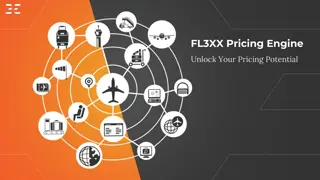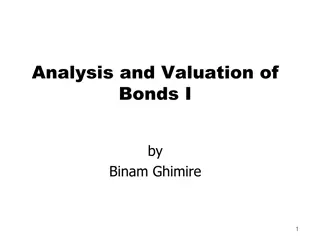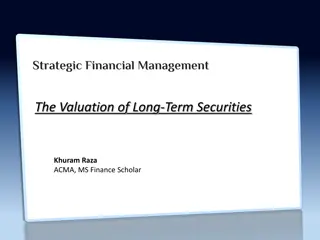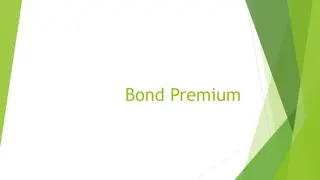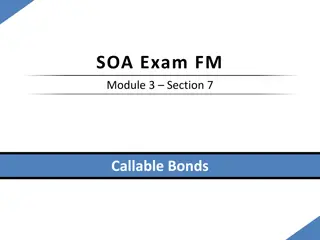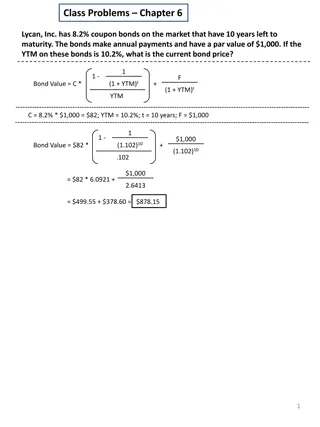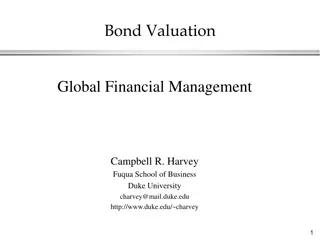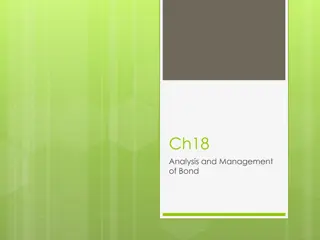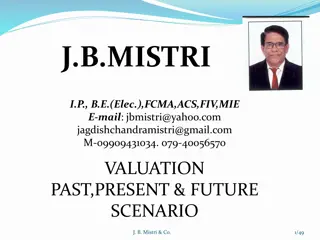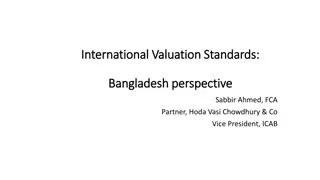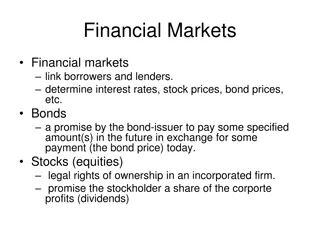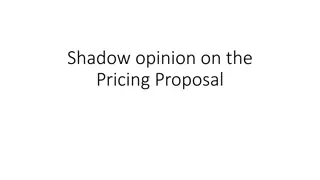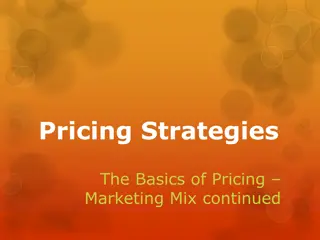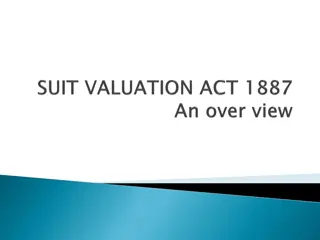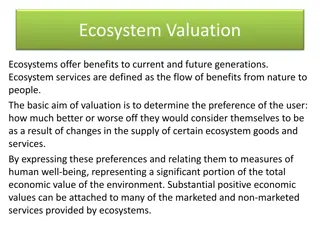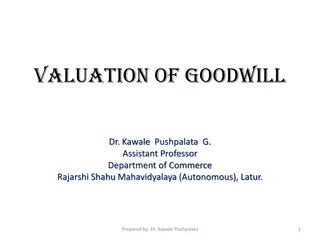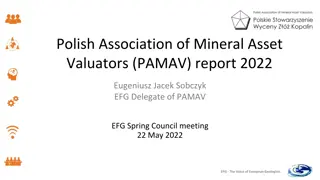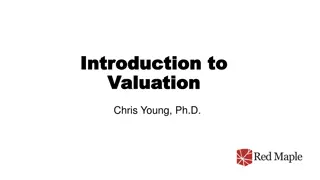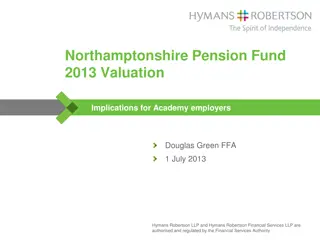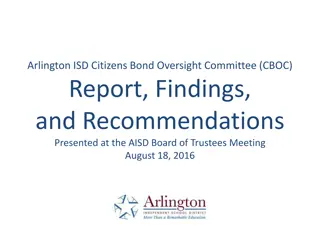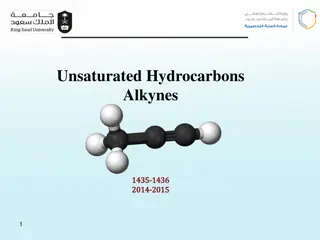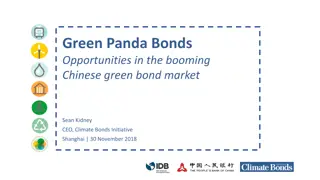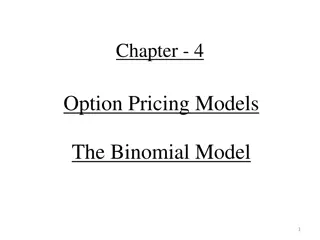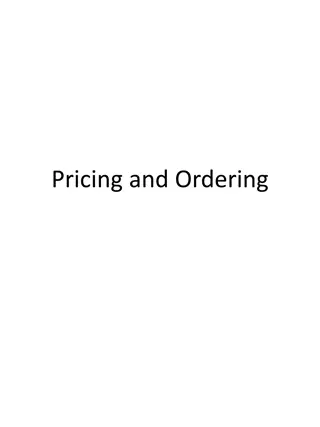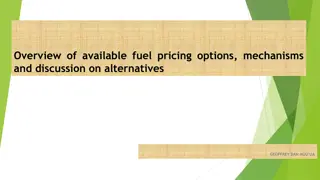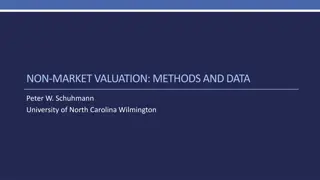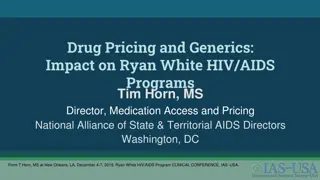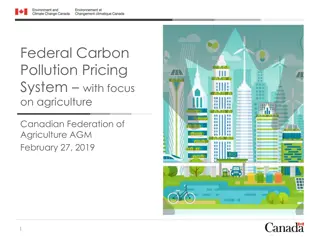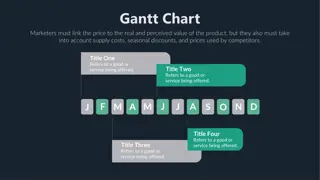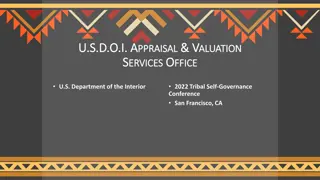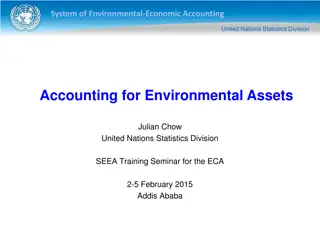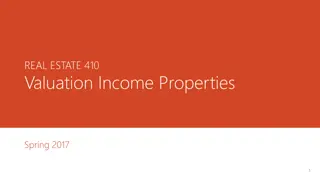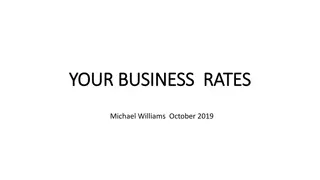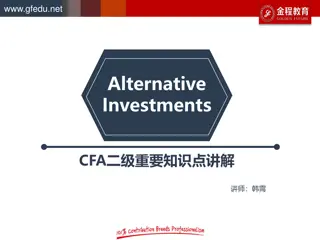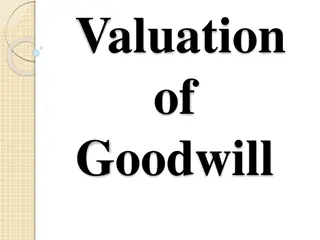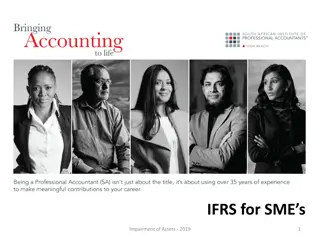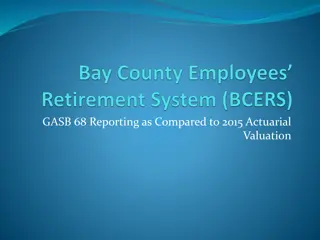Understanding Bond Valuation and Pricing
This informative content delves into valuing bonds, explaining concepts such as face value, coupon rates, and the relationship between bond prices and interest rates. It covers terminology, misconceptions about coupon rates, and provides examples to illustrate bond valuation calculations. The content also discusses valuing bonds as annuities and includes practical examples for better comprehension.
Download Presentation

Please find below an Image/Link to download the presentation.
The content on the website is provided AS IS for your information and personal use only. It may not be sold, licensed, or shared on other websites without obtaining consent from the author. Download presentation by click this link. If you encounter any issues during the download, it is possible that the publisher has removed the file from their server.
E N D
Presentation Transcript
1 Chapter 3 VALUING BONDS
Topics Covered 2 Using The Present Value Formula to Value Bonds How Bond Prices Vary With Interest Rates The Term Structure of Interest Rates Explaining the Term Structure Real and Nominal Rates of Interest The Risk of Default
Bonds 3 Terminology Bond - Security that obligates the issuer to make specified payments to the bondholder. Face value (par value or principal value) - Payment at the maturity of the bond. Coupon - The interest payments made to the bondholder. Coupon rate - Annual interest payment, as a percentage of face value.
Bonds 4 WARNING The coupon rate IS NOT the discount rate used in the present value calculations. The coupon rate merely tells us what cash flow the bond will produce Since the coupon rate is listed as a %, this misconception is quite common
Valuing a Bond 5 The price of a bond is the present value of all cash flows generated by the bond (i.e. coupons and face value) discounted at the required rate of return + cpn + cpn + ( cpn par ) = + + + PV .... + 1 2 t 1 ( ) 1 ( ) 1 ( ) r r r Note: cpn is commonly used as an abbreviation for coupon
Valuing a Bond 6 Example - France In October 2014 you purchase 100 euros of bonds in France which pay a 4.25% coupon every year. If the bond matures in 2018 and the YTM is 0.15%, what is the value of the bond? . 4 25 . 4 25 . 4 25 104 25 . = + + + PV ( . 1 ) ( . 1 ) ( . 1 ) 2 3 4 0015 . 1 0015 0015 0015 = euros 34 . 116
Valuing a Bond as an Annuity 7 PV(bond) = PV(annuity of coupons) + PV(principal) = + (bond) PV (cpn PVAF) (final payment discount factor) 1 1 + 100 = + . 4 25 ( ) ( ) 4 4 + 0015 . 0015 . 1 0015 . 1 0015 . = 116 34 .
Valuing a Bond 8 Example If today is October 1, 2015, what is the value of the following bond? An IBM Bond pays $115 every September 30 for 5 years. In September 2020 it pays an additional $1000 and retires the bond. The bond is rated AAA (WSJ AAA YTM is 7.5%) 115 115 115 115 , 1 115 = + + + + PV ( . 1 ) ( . 1 ) ( . 1 ) ( . 1 ) 2 3 4 5 . 1 075 075 075 075 075 = , 1 $ 161 84 .
Valuing a Bond 9 Example What is the price of a 7.25 % annual coupon bond, with a $1,000 face value, which matures in 3 years? Assume a required return of 0.35%. 72 50 . 72 50 . , 1 072 50 . = + + PV 1 2 3 . 1 ( 0035 ) . 1 ( 0035 ) . 1 ( 0035 ) = PV , 1 $ 205 56 .
Valuing a Bond 10 Example (continued) What is the price of a 7.25 % annual coupon bond, with a $1,000 face value, which matures in 3 years? Assume a required return of 0.35%. Bond prices are quoted as a percentage of par. Par value price % = $ price $1,000 price % = $1,205.56 price % = 120.56 %
Valuing a Bond 11 Q: How did the calculation change, given semi-annual coupons versus annual coupon payments? Twice as many payments, cut in half, over the same time period. $$ $$$$ $$$$ $$$$ $$$$ $$ $$ $$ $$ $$ $$ $$
Valuing a Bond 12 Example - USA In November 2014 you purchase a 3 year US Government bond. The bond has an annual coupon rate of 4.25%, paid semi-annually. If investors demand a 0.965% semiannual return, what is the price of the bond? 21 25 . 21 25 . 21 25 . 21 25 . 21 25 . 1021 25 . = + + + + + PV ( . 1 ) ( . 1 ) ( . 1 ) ( . 1 ) ( . 1 ) 2 3 4 5 6 004825 . 1 004825 004825 004825 004825 004825 = , 1 $ 096 90 .
Treasury Yields 13 The interest rate on 10-year U.S. Treasury bonds 1900-2012 16 14 12 10 Yield (%) 8 6 4 2012 2 0 1900 1903 1906 1909 1912 1915 1918 1921 1924 1927 1930 1933 1936 1939 1942 1945 1948 1951 1954 1957 1960 1963 1966 1969 1972 1975 1978 1981 1984 1987 1990 1993 1996 1999 2002 2005 2008 2011
Maturity and Prices 14 Different maturity bonds have different interest rate risk 2,500 30-year bond When the interest rate equals the 4.25% coupon, both bonds sell for the same value 2,000 Bond price ($) 1,500 1,000 3-year bond 500 0 0 1 2 3 4 5 6 7 8 9 0.5 1.5 2.5 3.5 4.5 5.5 6.5 7.5 8.5 9.5 10 Interest rate (%) = YTM
Bond Rates of Return 15 Rate of Return Total income per period per dollar invested total income Rate of return = investment coupon income + price change Rate of return = investment
Bond Rates of Return 16 Example A bond increases in price from $963.80 to $1,380.50 and pays a coupon of $21.875 during the same period. What is the rate of return? + 21 875 . 1380 ( 50 . 963 80 . ) = = Rate of return 455 . 963 80 . ROR = 45.5%
Duration Formula 17 3 PV ( ) 1 PV ( ) 2 PV ( ) PV ( ) C C C T C = + + + + 3 Duration ... 1 2 T PV PV PV PV duration + = = Modified duration volatility (%) 1 yield
Duration Calculation 19 Proportion of Total Value [PV(Ct)/V] 0.084 0.08 0.836 Proportion of Total Value Time Year Ct 100 100 1100 PV(Ct) at 5.0% 95.24 90.7 950.22 1 2 3 0.084 0.16 2.509 V = 1136.16 1 Duration= 2.753 years
Duration 20 Example Calculate the duration of our 6 7/8% bond @ 4.9% YTM Year CF PV@YTM % of Total PV % Year 1 68.75 65.54 .060 0.060 2 68.75 62.48 .058 0.115 3 68.75 59.56 .055 0.165 4 68.75 56.78 .052 0.209 5 1068.75 841.39 .775 3.875 Duration 4.424 1085.74 1.00
Duration & Bond Prices 21 Bond price, percent Interest rate, percent
Interest Rates 22 Short- and long-term interest rates do not always move in parallel. Between September 1992 and April 2000, U.S. short-term rates rose sharply while long term rates declined.
Term Structure of Interest Rates 23 YTM (r) 1981 1987 & Normal 1976 1 5 10 20 30 Year Spot Rate - The actual interest rate today (t = 0) Forward Rate - The interest rate, fixed today, on a loan made in the future at a fixed time Future Rate - The spot rate that is expected in the future Yield To Maturity (YTM) - The IRR on an interest bearing instrument
Yield Curve 24 U.S. Treasury Strip Spot Rates as of November 2014
Law of One Price 25 All interest bearing instruments are priced to fit the term structure This is accomplished by modifying the asset price The modified price creates a new yield, which fits the term structure The new yield is called the yield to maturity (YTM)
Yield to Maturity 26 Example $1,000 Treasury bond expires in 5 years. Pays coupon rate of 10.5%. What is YTM if market price is 107.88? C0 C1 105 C2 105 C3 105 C4 105 C5 1105 1078.80 Calculate IRR = 8.5%
Interest Rates & Inflation 29 In the presence of inflation, an investor s real interest rate is always less than the nominal interest rate 1 + real rate =1 + nominal rate 1 + inflation rate
Interest Rates & Inflation 30 Example If you invest in a security that pays 10% interest annually and inflation is 6%, what is your real interest rate? 1 + real rate =1.10 1.06 Real interest rate = .03774 or 3.774%
Default Risk 35 Default or Credit Risk - The risk that a bond issuer may default on its bonds Default premium - The additional yield on a bond that investors require for bearing credit risk Investment grade - Bonds rated Baa or above by Moody s or BBB or above by Standard & Poor s Junk bonds - Bond with a rating below Baa or BBB
Default Risk 36 Standard & Poor's Moody' s Safety Aaa AAA The strongest rating; ability to repay interest and principal is very strong. Very strong likelihood that interest and principal will be repaid Strong ability to repay, but some vulnerability to changes in circumstances Adequate capacity to repay; more vulnerability to changes in economic circumstances Considerable uncertainty about ability to repay. Likelihood of interest and principal payments over sustained periods is questionable. Bonds in the Caa/CCC and Ca/CC classes may already be in default or in danger of imminent default C-rated bonds offer little prospect for interest or principal on the debt ever to be repaid. Aa AA A A Baa BBB Ba B BB B Caa Ca C CCC CC C
Yield Spread 38 Yield Spreads between Corporate and 10-year Treasury Bonds
Sovereign Bonds and Default Risk 39 Sovereign Bonds and Default Risk Foreign currency debt Default occurs when foreign government borrows dollars If crisis occurs, governments may run out of taxing capacity and default Affects bond prices, yield to maturity
Sovereign Bonds and Default Risk 40 Sovereign Bonds and Default Risk Own currency debt Less risky than foreign currency debt Governments can print money to repay bonds
Sovereign Bonds and Default Risk 41 Sovereign Bonds and Default Risk Eurozone debt Can t print money to service domestic debts Money supply controlled by European Central Bank


